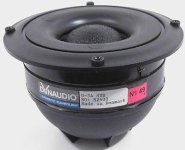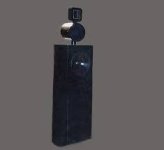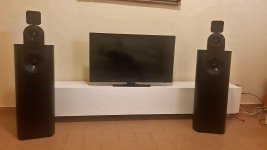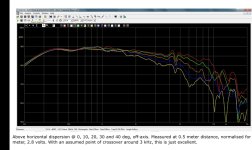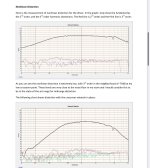I forgot to mention the array I have planned with the M74A and 4 x SS D7608s.
The SS domes will be arranged in a circle around the M74A and T34B. They will as a group only be supporting the lower end midrange output of the M74A, which will cover the full 500 - 3.5 khz midrange passband. The M74A will however start out lower in amplitude, gradually tapering up to full output at above 900 hz, then continue flat up to the collective 3.5 kHz midrange LP. At the same time, the 4 x surrounding D7608s will come in at 500 hz, gradually tapering down at 3 - 4 dB/oct, then shading out at a faster rate past 900 hz.
I know that sounds a little complicated, but theres a method to my madness. The idea with all this is flat summed midrange FR with the lower mid output being supported by the outer SS domes, taking the load off the M74A in the low mids to decrease HD at very high SPLs along with controlling directivity. Its essentially mimicking a larger driver without the commom beaming issues they have.
The SS domes will be arranged in a circle around the M74A and T34B. They will as a group only be supporting the lower end midrange output of the M74A, which will cover the full 500 - 3.5 khz midrange passband. The M74A will however start out lower in amplitude, gradually tapering up to full output at above 900 hz, then continue flat up to the collective 3.5 kHz midrange LP. At the same time, the 4 x surrounding D7608s will come in at 500 hz, gradually tapering down at 3 - 4 dB/oct, then shading out at a faster rate past 900 hz.
I know that sounds a little complicated, but theres a method to my madness. The idea with all this is flat summed midrange FR with the lower mid output being supported by the outer SS domes, taking the load off the M74A in the low mids to decrease HD at very high SPLs along with controlling directivity. Its essentially mimicking a larger driver without the commom beaming issues they have.
@tubelectron I think you'll be happy with the performance of those MD60N. I would consider changing the dampening in the rear chambers. I would try either merino wool or a combination of that with denim tapered in density along the chamber.
I like that idea, I've been planning something very similar. At first I thought I could use 3 driver in a triangle with the two lower ones only coming in below 1KHz. (B&O uses this triangle arrangement in beolab 90) However the polar pattern was asymmetrical so didn't like it. I had to go for 1 in the middle and 4 around the outside. Only at sim stage right now though and will no doubt take a long time to make it real since I have other priorities. I look forward to seeing what you make.I forgot to mention the array I have planned with the M74A and 4 x SS D7608s.
The SS domes will be arranged in a circle around the M74A and T34B. They will as a group only be supporting the lower end midrange output of the M74A, which will cover the full 500 - 3.5 khz midrange passband. The M74A will however start out lower in amplitude, gradually tapering up to full output at above 900 hz, then continue flat up to the collective 3.5 kHz midrange LP. At the same time, the 4 x surrounding D7608s will come in at 500 hz, gradually tapering down at 3 - 4 dB/oct, then shading out at a faster rate past 900 hz.
I know that sounds a little complicated, but theres a method to my madness. The idea with all this is flat summed midrange FR with the lower mid output being supported by the outer SS domes, taking the load off the M74A in the low mids to decrease HD at very high SPLs along with controlling directivity. Its essentially mimicking a larger driver without the commom beaming issues they have.
@Tenson I've successfully used this method of grouping drivers on flat wall mounted 2 way systems with 10 - 16 cm midbass drivers, achieving 40 hz f3 cutoff with low 90s dB/w system sensitivity.
In the case of 5 x larger midrange domes, the emissive surface area would be larger than that of an 8" driver with gain of about 6 dB sensitivity at frequencies below 1/3 of CTC WL spacing.
In the case of 5 x larger midrange domes, the emissive surface area would be larger than that of an 8" driver with gain of about 6 dB sensitivity at frequencies below 1/3 of CTC WL spacing.
I’ve measured the JA-0801 and it wasn’t that great. 🤪YAMAHA NS-1000M SPECS
Frequency Response: 40 – 20,000Hz Sensitivity: 90dB (1W input, measured at 1m) Impedance: 8Ω Power Capacity: 100W (continuous program) High Frequency Driver: JA0513 30mm (1.2″) Beryllium Dome Medium Frequency Driver: JA0801 88mm (3.5″) Beryllium Dome Low Frequency Driver: JA3055A 300mm (12″) Paper Diaphragm Crossover Frequencies: 500Hz & 6,000Hz Enclosure Type: Closed Enclosure Dimensions (HxWxD): 675x375x326mm (26.5×14.75×12.75″) Weight: 31kg (each speaker)
Production Year: 1974 Price When Launched: £340 for a pair Equivalent Present Day Price: £3,700 for a pair Current UK Price: £600 to £1,500 for a pair
88mm dome ... what a beast
i would love to see its THD vs SPL
Just kidding, they measure great, and these were 48 years old. This was a near-field measurement and was around the limit of the microphone, in terms of distortion. They also don’t have the resonance that the ATC mid had at 4.6kHz.
We have an anechoic chamber at the local university, but the last time I was there was before the pandemic. Studio foam wedges were placed around the driver, to the sides, bottom and behind the microphone to reduce reflections the best I could.
The dips in the response are distance dependant and don’t seem to manifest at 1m. I suspect it’s an artifact of the Helmholtz behavior of the diffuser ring and phase difference between the dome’s center to edges. The ringing at 22kHz is a filter.

The dips in the response are distance dependant and don’t seem to manifest at 1m. I suspect it’s an artifact of the Helmholtz behavior of the diffuser ring and phase difference between the dome’s center to edges. The ringing at 22kHz is a filter.
Last edited:
I am using my Dynaudio D54 dome midrange (54 mm dome) drivers for about 40 years now. I build some eletrostats in the day's which gave great clarity but i missed the more point source and punshy sound with more body in the mid range from my Dynaudio D54 drivers. They are limited about frequency range and i use them from 1200 Hz to 5 KHz where the Visaton RHT12S magnetostat takes over. They blend in very well with the mid range. My Vifa 21WP250 does all the heavy lifting in the bass and low midrange (40 - 1200 Hz) with a nice responce without ringing so i can use 6 dB filtering. The TL subwoofer does the work below 40 Hz. The D54 sounds great with all kind of music but excels with guitar, voices, saxophone and jazz in general, but is not shy from techno and other electronc music.
Attachments
Last edited:
D54 is a great mid dome, even by today's standards. It can't be crossed as low as the newer breed of neo domes, but above 800 hz it does things very well, even better than most other 50mm soft domes do in regards to dynamics and detail.
@tubelectron I think you'll be happy with the performance of those MD60N. I would consider changing the dampening in the rear chambers. I would try either merino wool or a combination of that with denim tapered in density along the chamber.
Thanks @profiguy : I think you already advised me on that subject, but would you please recall me the aims of such a damping modification ? 🤔
T
Your goal with extra dampening is smoothing out that compound / double hump in the impedance curve. That will reduce the inherent H3 peak these drivers have and clean up the lower mids.
This is probably the least understood function in audio. When the two wavefronts collide, some will argue that phase is predominant while others look at lobing and ripples in the response. Then there’s distance…..how those wavefronts sum the farther away you are.What can I read to learn (or can you explain?) what would lead to a situation where closer is not better?
Is it related to cabinet diffraction? Put a dip where the diffraction causes a boost? This would need a design where the xover point and diffraction boost match, so seems a rare case.
I think on an infinite baffle with time aligned drivers, closer would always reduce the dip in vertical response, right?
For me, this is the whole enchilada where dome mids are concerned…..or any mid /3 way speaker……the avoidance of phase and wavefront interaction in the 1-5khz region where all of the detail and spacial cues reside……I think if you’re crossing at more than 3.5k with pretty steep slopes, you’ve licked most of the problem……the higher the better. Cross below this and you might have well just built a two way. Jim is right……measurements and sims are only part of it.
AMTs are gaining huge amounts of ground these days…..regardless of their limited vertical dispersion…..or is it because of it?…….are they perceived to be more detailed for this reason?…..or do we perceive the clarity in the upper mids as there’s less wavefront interaction caused by the tweeter? All good questions.
While these do not meet my lifestyle or space constraints, the absolute best presentation I’ve ever heard was a 1.4” compression driver on a large waveguide that played 700hz to 15k +/- 3db……now that’s clarity as it solves nearly every problem……except the audiophool myths on what happens beyond a middle aged persons ability to hear…..mysteries and myths are all that’s left holding the exclusivity for audiophiles….that and how deep your pockets are.
Last edited:
I agree about dynamics and detail and also the benefit of wide dispersion of these domes. The frequency curve starts to be more flat above 1 KHz. Because i use 6 dB filtering i choose 1.2 KHz to avoid distorcion at higher levels. These domes have problems with lower midrange because of their limited size and excusion but for me, one of the best i heared, even compared with ESL. I am not a fan of line imaging.D54 is a great mid dome, even by today's standards. It can't be crossed as low as the newer breed of neo domes, but above 800 hz it does things very well, even better than most other 50mm soft domes do in regards to dynamics and detail.
Last edited:
@mayhem13 Interesting theory about wavefront interaction and some research conducted by the guys at Crown who designed the PZM boundary micing technology. There is supposed proof which states coherent wavefronts can simultaneously intersect and cross without production of sideband artifacts. Same holds true for LF energy at much longer wavelengths in relatively small rooms. There is no destructive interference observed when 2 or more wavefronts occupy the same physical volume of air.
@Henk Haring I still have a pair of D52 which are also very good. I cross those at 900 hz 2nd order and they keep up great with twin 8s.
@profiguy That's a great dome midrange as well, i think the same 54 mm dome with hexacoil and a smaller (but still big) magnet. Second order already makes a big difference, i crossed mine even lower, around 600 Hz 6 dB, but had a lot of distorcion so i double it to be sure. Sound wise i do not know if there is much diference between D52 and D54? These domes are still top of the line, i believe.. ;-) Looks like not so much has happend in the last 40 years about a major jump in basic speaker tech..
Last edited:
Hifi compass has done good measurements on domes.
https://hificompass.com/en/news
I think the primary virtue of a dome mid is the low mms. The Dayton 2 inch domes are some of the best value for money available
Zaph audio also did some revealing measurements of domes.
https://hificompass.com/en/news
I think the primary virtue of a dome mid is the low mms. The Dayton 2 inch domes are some of the best value for money available
Zaph audio also did some revealing measurements of domes.
@macka i agree on low mass but want to add that the dispersion patern of a dome mid range sounds to me more realistic and less of a "funnel" effect like I perceive with cones many times. Maybe a very small cone has less of this directional effect then 5 inch and more mid ranges. The combination of speed and dispersion of a dome creates a more life like sound for me. All at the background of a capable dome with a sufficient strong motor. Nice link about domes, thanks
I have use Dynaudio D54 std in my Edgar midrange horns for years. Great drivers.
it’s a shame they stopped selling drivers.
Volt have a 2 inch dome and a 3 inch version. Visation also.
Troel’s G had some good measurements of the ATC dome. Some other data from the late Geoff Bagley.
Volt have a 2 inch dome and a 3 inch version. Visation also.
Troel’s G had some good measurements of the ATC dome. Some other data from the late Geoff Bagley.
Attachments
Btw Eric Alexander’s Tektron loudspeakers that use up to 17 one inch or 34 mm dome tweeter has them covering the mid range.
So many drivers drops the demand on linear X max which is normally on 0.5mm on a tweeter.
Using Eric’s design 5 dome mid with a central tweeter would be interesting 🤨
So many drivers drops the demand on linear X max which is normally on 0.5mm on a tweeter.
Using Eric’s design 5 dome mid with a central tweeter would be interesting 🤨
- Home
- Loudspeakers
- Multi-Way
- The dome midrange thread
